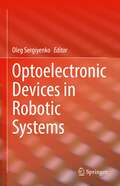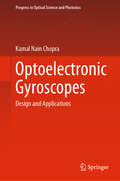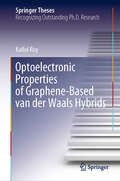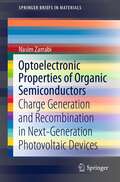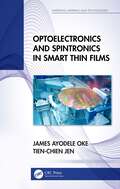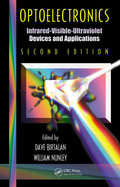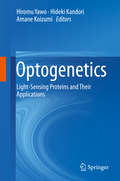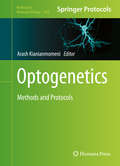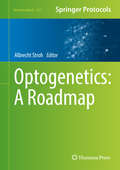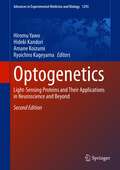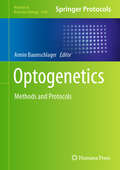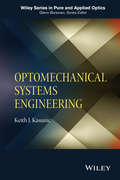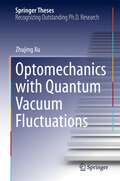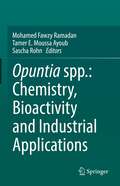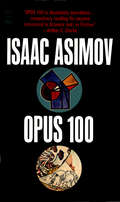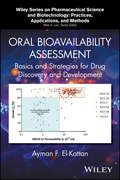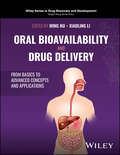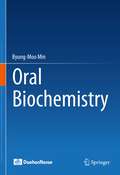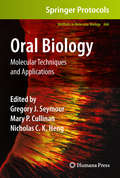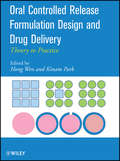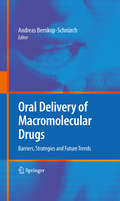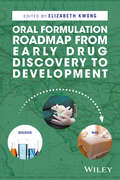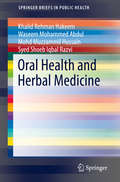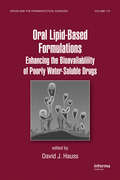- Table View
- List View
Optoelectronic Devices in Robotic Systems
by Oleg SergiyenkoThis book provides a wide scope of contributions related to optoelectronic device application in a variety of robotic systems for diverse purposes. The contributions are focused on optoelectronic sensors and analyzing systems, 3D and 2D machine vision technologies, robot navigation, pose estimations, robot operation in cyclic procedures, control schemes, motion controllers, and intelligent algorithms and vision systems. Applications of these technologies are outlined for unmanned aerial vehicles, autonomous and mobile robots, industrial inspection applications, cultural heritage documentation, and structural health monitoring. Also discussed are recent advanced research in measurement and others areas where 3D and 2D machine vision and machine control play an important role. Surveys and reviews about optoelectronic and vision-based applications are also included. These topics are of interest to readers from a diverse group including those working in optoelectronics, and electrical, electronic and computer engineering.
Optoelectronic Gyroscopes: Design and Applications (Progress in Optical Science and Photonics #11)
by Kamal Nain ChopraThe book presents the detailed study of optoelectronic gyroscopes, especially Ring Laser Gyroscopes (RLGs) and Fiber Optic Gyroscopes (FOGs). It discusses their design in detail to optimize their performance, besides explaining the related concepts and the new developments. Other topics covered in this book are double ion beam sputtering for fabricating RLG mirrors on the high quality optical substrates, optical testing, and thin films characterization techniques. The book will be useful for the researchers, professionals, and engineers working in the areas of optical gyroscopes and the related technologies.
Optoelectronic Properties of Graphene-Based van der Waals Hybrids (Springer Theses)
by Kallol RoyThis thesis deals with the development and in-depth study of a new class of optoelectronic material platform comprising graphene and MoS_2, in which MoS_2 is used essentially to sensitize graphene and lead to unprecedently high gain and novel opto-electronic memory effects. The results presented here open up the possibility of designing a new class of photosensitive devices which can be utilized in various optoelectronic applications including biomedical sensing, astronomical sensing, optical communications, optical quantum information processing and in applications requiring low intensity photodetection and number resolved single photon detection.
Optoelectronic Properties of Organic Semiconductors: Charge Generation and Recombination in Next-Generation Photovoltaic Devices (SpringerBriefs in Materials)
by Nasim ZarrabiThis book focuses on organic semiconductors with particular attention paid to their use as photovoltaic devices. It addresses a fundamental and hitherto overlooked concept in the field of organic optoelectronics, namely the role that sub-gap states play in the performance of organic semiconducting devices. From a technological point of view, organic semiconductor-based devices are of significant interest due to their lightweight, ease of processability, conformal flexibility, and potentially low cost and low embodied energy production. Motivated by these rather unique selling points, the performance of organic semiconductors has been a subject of multidisciplinary study for more than 60 years with steady progress in applications such as solar cells, transistors, light emitting diodes, and various sensors.The book begins with a review of the main electro-optical phenomena in organic solar cells and presents a new method for measuring exciton diffusion lengths based on a low-quencher-content device structure. Furthermore, the book reveals how mid-gap trap states are a universal feature in organic semiconductor donor–acceptor blends, unexpectedly contributing to charge generation and recombination, and having profound impact on the thermodynamic limit of organic photovoltaic devices. Featuring cutting-edge experimental observations supported with robust and novel theoretical arguments, this book delivers important new insight as to the underlying dynamics of exciton generation and diffusion, charge transfer state dissociation, and indeed the ultimate fate of photogenerated free carriers.
Optoelectronics and Spintronics in Smart Thin Films (Emerging Materials and Technologies)
by Tien-Chien Jen James Ayodele OkeSmart thin films, composed of functional materials deposited in thin layers, have opened new avenues for the development of flexible, lightweight, and high-performance devices. Optoelectronics and Spintronics in Smart Thin Films presents a comprehensive overview of this emerging area and details the current and near future integration of smart thin films in solar cells, and memory storage. Offers an overview of optoelectronics and spintronics. Discusses synthesis of smart nanomaterials. Describes deposition techniques and characterization of thin films. Considers the integration and application of opto-spintronics for technological advancement of solar cells and memory storage devices. Focused on advancing research on this evolving subject, this book is aimed at advanced students, researchers, and engineers in materials, chemical, mechanical, and electrical engineering, as well as applied physics.
Optoelectronics: Infrared-Visable-Ultraviolet Devices and Applications, Second Edition (Optical Science and Engineering)
by Dave Birtalan William NunleyOrganized as a mini-encyclopedia of infrared optoelectronic applications, this long awaited new edition of an industry standard updates and expands on the groundbreaking work of its predecessor. Pioneering experts, responsible for many advancements in the field, provide engineers with a fundamental understanding of semiconductor physics and the technical information needed to design infrared optoelectronic devices. Fully revised to reflect current developments in the field, Optoelectronics: Infrared-Visible-Ultraviolet Devices and Applications, Second Edition reviews relevant semiconductor fundamentals, including device physics, from an optoelectronic industry perspective. This easy-reading text provides a practical engineering introduction to optoelectronic LEDs and silicon sensor technology for the infrared, visible, and ultraviolet portion of the electromagnetic spectrum. Utilizing a practical and efficient engineering approach throughout, the text supplies design engineers and technical management with quick and uncluttered access to the technical information needed to design new systems.
Optogenetics
by Hiromu Yawo Hideki Kandori Amane KoizumiThe subject of optogenetics is comprehensively covered in this book, including physical, chemical, and biological topics of light-sensing proteins and their application in biological systems, particularly in neuroscience and medicine and the related opto-electronics. Optogenetics is a new technology that combines genetics and optics. It enables one to manipulate or measure the function of identified cells or neurons in a tissue by light with an accuracy in the range of milliseconds, even in a freely moving animal. Optogenetics has already become a powerful tool for revealing the neural mechanisms underlying behavior and analyzing various physiological phenomena. It is also expected to become useful for treating neural dysfunctions such as Parkinson disease and for the development of a brain-machine interface. This book should be read by any scientist or student performing research in any way related to optogenetics. As a milestone publication on optogenetics, this book will serve as a compass for any researcher, from beginners to experts, to explore this uncharted world.
Optogenetics
by Krishnarao Appasani Appasani Krishnarao Nagel Georg Georg NagelDiscovered little more than a decade ago, optogenetics - a revolutionary technique combining genetic and optical methods to observe and control the function of neurons - is now a widely used research tool. Optogenetics-driven research has led to insights into Parkinson's disease and other neurological and psychiatric disorders. With contributions from leaders and innovators from both academia and industry, this volume explores the discovery and application of optogenetics, from the basic science to its potential clinical use. Chapters cover a range of optogenetics applications, including for brain circuits, plasticity, memory, learning, sleep, vision and neurodegenerative and neuropsychiatric diseases. Providing authoritative coverage of the huge potential that optogenetics research carries, this is an ideal resource for researchers and graduate students, as well as for those working in the biotechnology and pharmaceutical industries and in a clinical setting.
Optogenetics
by Arash KianianmomeniThis volume provides researchers with up-to-date protocols and takes aclose look at current research and promising applications. Optogenetics:Methods and Protocols contains a collection of recently developed technicalprotocols on optogenetic applications in neuroscience, brain mapping, treatmentof neurological disorders, and restoration of visual function. Severalintroductory and discussion chapters offer a wide overview about sources anddiversity of optogenetic tools, design strategies, and potential applicationsin other fields like plant research. Written in the highly successful Methodsin Molecular Biology series format, chapters include introductions to theirrespective topics, lists of the necessary materials and reagents, step-by-step,readily reproducible laboratory protocols, and tips on troubleshooting andavoiding known pitfalls. Cutting edge and thorough, Optogenetic: Methods and Protocols, deliversan interdisciplinary view of optogenetic applications and its potential todevelop as a valuable tool for basic research, as well as biomedical andbiotechnological applications.
Optogenetics: A Roadmap
by Albrecht StrohThis volume focuses on the optogenetics workflow, and covers topics on viral vectors, targeting strategies, choice on opsins, animal models and readouts, and applications in systems neuroscience. This book shows readers how to identify the critical aspects of each methodological step, and how to determine the necessary level of complexity to address the particular research question. In Neuromethods series style, chapters include the kind of detail and key advice from the specialists needed to get successful results in your laboratory. Comprehensive and cutting-edge, Optogenetics: A Roadmap is a valuable guide for both the optogenetics novices and the experts.
Optogenetics: Light-Sensing Proteins and Their Applications in Neuroscience and Beyond (Advances in Experimental Medicine and Biology #1293)
by Ryoichiro Kageyama Hiromu Yawo Hideki Kandori Amane KoizumiThis book, now in a thoroughly revised second edition, offers a comprehensive review of the rapidly growing field of optogenetics, in which light-sensing proteins are genetically engineered into cells in order to acquire information on cellular physiology in optical form or to enable control of specific network in the brain upon activation by light. Light-sensing proteins of various living organisms are now available to be exogenously expressed in neurons and other target cells both in vivo and in vitro. Cellular functions can thus be manipulated or probed by light. The new edition documents fully the extensive progress since publication of the first edition to provide an up-to-date overview of the physical, chemical, and biological properties of light-sensing proteins and their application in biological systems, particularly in neuroscience but also in medicine and the optical sciences. Underlying principles are explained and detailed information provided on a wide range of optogenetic tools for the observation and control of cellular signaling and physiology, gene targeting technologies, and optical methods for biological applications. In presenting the current status of optogenetics and emerging directions, this milestone publication will be a “must read” for all involved in research in any way related to optogenetics.
Optogenetics: Methods and Protocols (Methods in Molecular Biology #2840)
by Armin BaumschlagerThis volume explores the latest advancements in the field of optogenetics and how it uses cellular light-sensing components and genetic engineering to control proteins and biological processes. The book chapters are organized into four parts. Part One focuses on intracellular optogenetic components for control of specific cell functions; Part Two looks at externally supplied light regulators that do not require genetic manipulation of target cells; Part Three highlights optogenetic control of organelles, and Part Four introduces technical tools required for light induction in optogenetic experiments, as well as a method for performing and analyzing optogenetic cell-cell adhesion. Written in the highly successful Methods in Molecular Biology series format, chapters include introductions to their respective topics, lists of the necessary materials and reagents, step-by-step, readily reproducible laboratory protocols, and tips on troubleshooting and avoiding known pitfalls. Cutting-edge and practical, Optogenetics: Methods and Protocols is a valuable resource to help researchers understand and apply the concepts of optogenetics and the underlying bioengineering principles, and establish the required technical light-illumination setups for administering light inputs and analysis of experimental outcomes.
Optomechanical Systems Engineering
by Keith J. KasunicCovers the fundamental principles behind optomechanical design This book emphasizes a practical, systems-level overview of optomechanical engineering, showing throughout how the requirements on the optical system flow down to those on the optomechanical design. The author begins with an overview of optical engineering, including optical fundamentals as well as the fabrication and alignment of optical components such as lenses and mirrors. The concepts of optomechanical engineering are then applied to the design of optical systems, including the structural design of mechanical and optical components, structural dynamics, thermal design, and kinematic design. Optomechanical Systems Engineering: Reviews the fundamental concepts of optical engineering as they apply to optomechanical design Illustrates the fabrication and alignment requirements typically found in an optical system Examines the elements of structural design from a mechanical, optical, and vibrational viewpoint Develops the thermal management principles of temperature and distortion control Describes the optomechanical requirements for kinematic and semi-kinematic mounts Uses examples and case studies to illustrate the concepts and equations presented in the book Provides supplemental materials on a companion website Focusing on fundamental concepts and first-order estimates of optomechanical system performance, Optomechanical Systems Engineering is accessible to engineers, scientists, and managers who want to quickly master the principles of optomechanical engineering.
Optomechanics with Quantum Vacuum Fluctuations (Springer Theses)
by Zhujing XuThis thesis presents the first realization of non-reciprocal energy transfer between two cantilevers by quantum vacuum fluctuations. According to quantum mechanics, vacuum is not empty but full of fluctuations due to zero-point energy. Such quantum vacuum fluctuations can lead to an attractive force between two neutral plates in vacuum – the so-called Casimir effect – which has attracted great attention as macroscopic evidence of quantum electromagnetic fluctuations, and can dominate the interaction between neutral surfaces at small separations. The first experimental demonstration of diode-like energy transport in vacuum reported in this thesis is a breakthrough in Casimir-based devices. It represents an efficient and robust way of regulating phonon transport along one preferable direction in vacuum. In addition, the three-body Casimir effects investigated in this thesis were used to realize a transistor-like three-terminal device with quantum vacuum fluctuations. These two breakthroughs pave the way for exploring and developing advanced Casimir-based devices with potential applications in quantum information science. This thesis also includes a study of the non-contact Casimir friction, which will enrich the understanding of quantum vacuum fluctuations.
Opuntia spp.: Chemistry, Bioactivity and Industrial Applications
by Mohamed Fawzy Ramadan Tamer E. Moussa Ayoub Sascha RohnThe Opuntia fruits, commonly known as cactus pears or prickly pears, have been suggested by the Food and Agriculture Organization to be a promising and strategic crop in regions suffering from lack of water. In Mexico, India, South Africa, and the Mediterranean, the Opuntia fruits have become popular due to their nutritive value and health-promoting benefits, including antioxidant, antiulcerogenic and antiatherogenic traits and protective effects against LDL oxidation. Additionally, readily absorbable sugars, high vitamin C and mineral content, and a pleasant flavour make Opuntia tailor-made for novel foods. Due to their ecological advantages, high functional value, and health-related traits, Opuntia fruits can be highly exploited in different food processing applications. For instance, Opuntia cactus fruits are used for the preparation of juices and marmalades; Opuntia cactus plants are used to feed animals in African and Latin American countries; Peruvian farmers cultivate Opuntia cactus for growing the cochineal (Dactylopius coccus) insect and producing the natural dye carmine; and the commercial production of food and non-food products from Opuntia has been established in Mexico, USA and several Mediterranean countries. Opuntia spp.: Chemistry, Bioactivity and Industrial Applications creates a multidisciplinary forum of discussion on Opuntia cactus with special emphasis on its horticulture, post-harvest, marketability, chemistry, functionality, health-promoting properties, technology and processing. The text includes detailed discussion of the impact of traditional and innovative processing on the recovery of high-added value compounds from Opuntia spp. by-products. Later chapters explore the potential applications of Opuntia spp. in food, cosmetics and pharmaceutical products.
Opus 100
by Isaac AsimovASIMOV THE GREATEST Isaac Asimov needs no introduction. As the COLUMBUS DISPATCH declares, he is “the man who legitimized Science Fiction in the United States." But this is just part of the fabulous Asimov story. For this bestselling author has also explored virtually every branch of human knowledge in his mind- expanding writings. Now, in a blend of Science and Fiction that only he could achieve, Isaac Asimov takes you on a personally guided tour of the brightest adventures and delights in the Asimov galaxy.
Oral Bioavailability Assessment: Basics and Strategies for Drug Discovery and Development
by Mike S. Lee Ayman F. El-KattanSpecifically geared to personnel in the pharmaceutical and biotechnology industries, this book describes the basics and challenges of oral bioavailability – one of the most significant hurdles in drug discovery and development.• Describes approaches to assess pharmacokinetics and how drug efflux and uptake transporters impact oral bioavailability• Helps readers reduce the failure rate of drug candidates when transitioning from the bench to the clinic during development• Explains how preclinical animal models – used in preclinical testing – and in vitro tools translate to humans, which is an underappreciated and complicated area of drug development• Includes chapters about pharmacokinetic modelling, the Biopharmaceutics Drug Disposition Classification System (BDDCS), and the Extended Clearance Classification System (ECCS)• Has tutorials for applying strategies to medicinal chemistry practices of drug discovery/development
Oral Bioavailability and Drug Delivery: From Basics to Advanced Concepts and Applications (Wiley Series in Drug Discovery and Development)
by Ming Hu Xiaoling LiORAL BIOAVAILABILITY AND DRUG DELIVERY Improve the performance and viability of newly-developed and approved drugs with this crucial guide Bioavailability is the parameter which measures the rate and extent to which a drug reaches a user’s circulatory system depending on the method of administration. For example, intravenous administration produces a bioavailability of 100%, since the drugs are injected directly into the circulatory system; in the case of oral administration, however, bioavailability can vary widely based on factors which, if not properly understood, can result in a failure in drug development, adverse effects, and other complications. The mechanics of oral bioavailability are therefore critical aspects of drug development. Oral Bioavailability and Drug Delivery provides a comprehensive coverage of this subject as well as its drug development applications. Beginning with basic terminology and fundamental concepts, it provides a thorough understanding of the challenges and barriers to oral bioavailability as well as the possibilities for improving this parameter. The resulting book is an indispensable tool for drug development research. Oral Bioavailability and Drug Delivery readers will also find: Discussion questions in many chapters to facilitate comprehension Detailed discussion of topics including dissolution, absorption, metabolism, and more Real-world examples of methods in actions throughout Oral Bioavailability and Drug Delivery is ideal for pharmaceutical and biotechnology scientists working in drug discovery and development; researchers in chemistry, biology, pharmacology, immunology, neuroscience, and other related fields; and graduate courses in drug development and delivery.
Oral Biochemistry
by Byung-Moo MinThis book provides the reader with a comprehensive understanding of oral biochemistry by explaining the role of basic biochemistry and dentistry concepts and identifying their metabolic processes of soft tissues that comprise oral and maxillofacial anatomy. The book also discusses how metabolic abnormalities are related to the development of oral diseases. Readers will gain a comprehensive perspective on a variety of oral conditions and related metabolic abnormalities. Individual chapters are focused on crucial topics such as enamel, dentine, saliva, fluoride, and many more. The importance of evidence-based explanation and case study details are also highlighted. Oral biochemistry is the first book to be devoted entirely to this area, and it will be of interest to researchers, students, and practitioners.
Oral Biology
by Mary P. Cullinan Gregory J. Seymour Nicholas C.K. HengWith so many major advances over the past two decades coming through the application of molecular biology and nanotechnology, it is essential that dental research, education, and practice keep pace with the rapid progress of science. In Oral Biology: Molecular Techniques and Applications, expert researchers in the field have provided a selection of in depth methods and techniques optimized for particular applications, which can be readily adapted to particular organisms or areas of interest. Divided into three convenient sections, the book covers the study of saliva, as it is a rich source of biomolecules for study at the molecular level, which may lead to the identification of susceptibility to particular diseases, the study of the microbial inhabitants that share the oral cavity with us, as well as a range of protocols that facilitate assessment of the molecular behavior of oral cells and tissues in health and during disease progression. Written in the highly successful Methods in Molecular BiologyTM series format, chapters include introductions to their respective topics, lists of the necessary materials and reagents, step-by-step, reproducible laboratory protocols, and tips on troubleshooting and avoiding known pitfalls. Authoritative and cutting-edge, Oral Biology: Molecular Techniques and Applications is an ideal resource not only to the new researcher but also to the seasoned laboratory veteran including cell biologists, microbiologists, and any researchers intent on delving into the vital world of oral biology.
Oral Controlled Release Formulation Design and Drug Delivery
by Kinam Park Hong WenThis book describes the theories, applications, and challenges for different oral controlled release formulations. This book differs from most in its focus on oral controlled release formulation design and process development. It also covers the related areas like preformulation, biopharmaceutics, in vitro-in vivo correlations (IVIVC), quality by design (QbD), and regulatory issues.
Oral Delivery of Macromolecular Drugs
by Andreas Bernkop-SchnürchRecent and rapid progress in the field of biotechnology has resulted in an increasing number of novel macromolecular drugs with great promise for further advanced research and clinical application. However, the delivery of these macromolecular drugs by routes other than the parenteral route is difficult. The pipeline of macromolecular drugs derived from biotechnology presents a challenging opportunity to develop practical dosage forms that could be dosed via the oral route. Given this, the successful oral delivery of macromolecular drugs presents an enormous opportunity. Oral Delivery of Macromolecular Drugs will provide an overview of the innovative oral delivery technologies that have demonstrated success in human testing and will go on to cite the challenges, strategies, and future trends that are to be expected.
Oral Formulation Roadmap from Early Drug Discovery to Development
by Elizabeth KwongDetailing formulation approaches by stage of discovery to early development, this book gives a “playbook” of practical and efficient strategies to formulate drug candidates with the least chance of failing in clinical development. • Comes from contributing authors with experience developing formulations on the frontlines of the pharmaceutical industry• Focuses on pre (or non-) clinical and early stage development, the phases where most compounds are used in drug research• Features case studies to illustrate practical challenges and solutions in formulation selection• Covers regulatory filing, drug metabolism and physical and chemical properties, toxicology formulation, biopharmaceutics classification system (BCS), screening approaches, early stage clinical formulation development, and outsourcing
Oral Health and Herbal Medicine (SpringerBriefs in Public Health)
by Khalid Rehman Hakeem Waseem Mohammed Abdul Mohd Muzzammil Hussain Syed Shoeb RazviOral health loss is one of the major problems existing all over the world and is one of the top causes of death when unmanaged. The oral cavity is home to numerous pathogenic microorganisms, some of which are responsible for the progression and development of various systemic diseases such as cancer, diabetes and myocardial infarction. Worldwide, 60–90% of school children and nearly 100% of adults have dental cavities, often leading to pain and discomfort. There are implications for the global economy as well, due to the continuous burden of investing resources to maintain oral hygiene. Not surprisingly, developing countries are disproportionally affected. There is thus an urgent need to develop economical solutions for the treatment of oral diseases. The trend of exploring plants or plant-derived compounds for the prevention and cure of death-causing diseases is on the rise. The use of traditional medicine for oral diseases is an ancient practice in which medicinal herbs play a major role. Medicinal plants have minimal side effects and no denigrating properties. Accordingly the use of medicinal plants to curtail oral pathogens has been reported by a number of studies.The present book updates the issues related to oral health, oral diseases and the role of medicinal plants in overcoming orally-derived health problems. We also highlight the knowledge gaps in oral health related problems with medicinal plants as one of the solutions. Our ultimate goal is to encourage future research and application of medicinal plants for economical and efficient treatment of oral diseases.
Oral Lipid-Based Formulations: Enhancing the Bioavailability of Poorly Water-Soluble Drugs (Drugs and the Pharmaceutical Sciences)
by David J. HaussOral lipid-based formulations are attracting considerable attention due to their capacity to facilitate gastrointestinal absorption and reduce or eliminate the effect of food on the absorption of poorly water-soluble, lipophilic drugs. Despite the obvious and demonstrated utility of these formulations for addressing a persistent and growing problem
